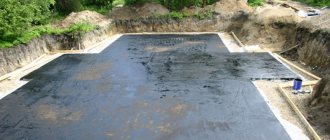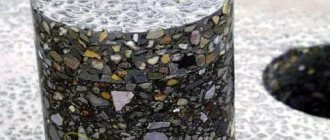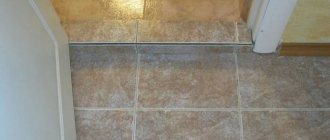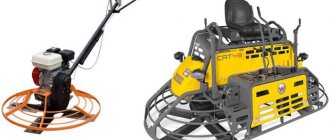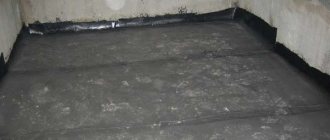Apartment renovation involves many aspects. One of them is major floor finishing, which includes several types of work. This includes waterproofing, pouring screed, and, if necessary, laying a heated floor system and other communications, as well as finishing the surface. Each of these aspects is very important, because only by following all the technology for proper floor repair can you achieve a solid foundation and high-quality work. Waterproofing the floor under the screed must be done, as it can not only protect the concrete covering from destruction, but also protect the property of neighbors in the event of some unforeseen situations.
Waterproofing the floor under the screed
What is a screed?
Before we talk about waterproofing measures for the surface of a rough foundation, you should find out what a screed is and why it is needed. So, a screed is a special coating, a durable layer that will serve as the basis for the finishing floor covering. It is necessary to ensure that the surface on which the finishing will be laid becomes perfectly flat. In this way, it will be possible to protect the finishing material from premature deformation and destruction, and also to achieve a smooth horizontal surface.
Concrete floor screed
There are several types of screed.
- Concrete or cement - one of the varieties of wet screed. The most familiar option for most apartment and house owners. It is carried out by pouring the rough foundation with a special construction mixture made from cement and water, sometimes with the addition of various polymer components.
Floor diagram with screed
- Self-leveling – also a type of wet screed. Only it is done with special mixtures, which themselves can be evenly distributed over the surface of the rough base in such a way that they will create a perfectly flat surface.
Self-leveling screed
- Dry screed - performed using bulk materials without water, as well as using gypsum fiber laid on logs. The fastest way to level the floor.
Dry floor screed and installation of gypsum fiber boards
On a note! The drying time for the screed is about a month. It is necessary to wait this time, so it is not possible to continue finishing work immediately after pouring the screed layer. There are, of course, quick-drying mixtures that reduce the waiting time, but you still won’t be able to work on the base on the first day in any case. The fastest option is a dry screed, but it is not recommended to install it in rooms with high humidity.
Checking the floor level
Screed is necessary in premises of any purpose, especially in residential buildings and apartments. This is the ideal base for any type of finish, be it a coat of paint or an expensive laminate.
Roll products
Most often, these materials are a mixture of bitumen and synthetic components based on fiberglass. They are characterized by reliability and durability. Previously, they were made on a paper basis, which reduced their service life. Such materials are still available today, but despite their low price, purchasing them is not recommended.
Rolled waterproofing can be pasted or welded. The first materials are attached to the base, and for the installation of the surfaced ones, special construction burners are needed that run on gas and heat the bitumen contained in them. Quite often, waterproofing a wooden floor in a private house is done with just such a material, although there are other options.
The sequence of work is as follows:
- First, the base is prepared: it is cleaned of debris and dust, and all cracks and other defects are rubbed with a solution of sand and cement.
- When using roofing felt, priming is performed with bitumen emulsion. The base slabs are additionally treated with penetrating insulating agents.
- Damper tape is laid along the edges of the room. This is required to compensate in case of expansion of the screed, which occurs due to temperature changes.
- Insulating sheets are laid with an overlap of 15 centimeters on the walls and 10-15 centimeters on top of each other, thereby creating a kind of recess. If particularly high-quality waterproofing of a rough screed is required, for example, in a bathroom, then the material is laid in several layers, shifting the joints (read: “Waterproofing screed - how to do it correctly, choosing a floor option”).
- The overlapping sheets are fastened using a hair dryer. If weldable materials are used, they are heated with a burner before fastening. Pieces of roofing material are attached with bitumen mastic to the previous layer and base. The joining seams are connected in the same way.
- When air bubbles and folds appear, these areas are pierced with a knife and smoothed out well, thereby removing the air. Afterwards, the edges of the cut are folded back, coated with mastic and attached to the base.
Such waterproofing of a concrete floor screed is inexpensive and reliable, but requires a significant amount of time and the availability of special tools.
Waterproofing the floor before screed
Waterproofing is one of the activities carried out during floor renovation. It is done before pouring the screed and protects the room from moisture from the outside, and also protects other adjacent rooms from water from the renovated room getting into them. Waterproofing will also protect the concrete screed itself from the effects of moisture vapor, which is especially important if the room in which the repair is being carried out is located above the basement. If the cement base is constantly exposed to moisture, it will quickly begin to lose its performance characteristics - deteriorate, crack - and will last much less than it could.
Photos of cracks that have occurred
Attention! Waterproofing is especially important in areas where there is a risk of water leaks. For example, this could be a bathroom, kitchen, toilet, etc.
In the event of flooding of a room that does not have a waterproofed floor, the water will very quickly, under the influence of gravity, flow down through microcracks and pores, of which there are a great many in the structure of concrete. Thus, the liquid will seep to the lower floors and flood the neighbors or basement. Water can also get below the joints between the walls and the floor - usually in these places there are quite wide cracks.
Rolled floor waterproofing
Another advantage of laying a waterproofing layer is that it protects the health of people living in the apartment. If moisture cannot enter the room from the outside and accumulate in the area of the concrete screed, then the spread of fungi and mold, which so love a humid environment, will not occur. This means that they will not threaten human health.
Waterproofing the base under the screed
The need to install waterproofing also lies in further high-quality work. If a waterproofing layer is laid, then the application of the mortar for the screed will be much better and smoother.
Attention! Waterproofing the floor is extremely necessary for those structures that do not have basements. They are extremely susceptible to moisture coming to them from the soil.
Some people believe that waterproofing is enough to do in the kitchen or bathroom, but this is far from true. A water-repellent coating must be laid in all rooms, because each of them has heating system pipes that can also suddenly leak.
Painting waterproofing
On a note! Materials for waterproofing are not that expensive, which means you can quite allocate a certain amount from your budget and still complete the protective part of the work. In the event of a flood, this will be more profitable than paying for damaged repairs to neighbors.
How to insulate a wooden floor on the first floor: various technologies
Insulating the wooden floor of the first floor is not a technologically complex process - it would be more correct to call it labor-intensive. To implement it, you will need to completely remove the existing wooden flooring and, without disturbing the position of the joists, remove from underneath it the construction debris that is found there in abundance. Next, lay the insulation and restore everything in place. This is provided that dampness does not penetrate from the basement to the first floor. If she finds loopholes, then she will have to remove the logs, make high-quality waterproofing, and only then restore everything to its place.
Sequence of floor insulation on the first floor
In general, if you are going to start a renovation, then you need to do it on a large scale and look far ahead - restoring an old wooden flooring does not make any sense, unless, of course, we are talking about global savings on the purchase of new building materials. It's no secret that remodeling is much more difficult than doing it from scratch - here the same principle works one hundred percent. It is not possible to make high-quality (smooth and without cracks) wooden flooring from old boards, twisted by time and endless changes in humidity, without special equipment. If you want to save on installing a subfloor, use modern board materials instead of new boards - OSB or chipboard are much cheaper, and with the right approach to installation they last quite a long time. Do not forget about underground ventilation - without it, flooring made of boards or modern slabs will quickly rot.
Floor insulation on the first floor OSB photo
It is impossible to ignore modern alternative solutions to this problem - the cold floor on the ground floor can simply be heated using underfloor heating systems for these purposes. Today there are three of them - electric floor heating, infrared and water heated floors. They will not only bring warmth into your home, but will also dry out the floor slabs, depriving the fungus of its usual habitat. It is necessary to choose one or another underfloor heating system based on the availability of individual heating. If it is available, then it is better to give preference to a water heated floor; if not, then only electric systems.
Heating of the floor covering with a warm floor system photo
This is exactly what insulation of the ground floor floor looks like - in principle, this technology is standard in almost all cases. Most importantly, do not violate it and do not disdain the preparatory work, which in this situation involves working with the seams of the floor slabs - they must first be cleared, then sealed with polyurethane foam, after which it has dried, sealed with cement mortar. Only after this can you begin further work.
Choose reliable craftsmen without intermediaries and save up to 40%!
- Fill out the application
- Receive offers with prices from masters
- Select performers by price and reviews
Order waterproofing of the floor in the apartment
Our website will help you quickly find a private craftsman or team to perform any repair work. Just place your request, and within a few minutes you will receive offers with prices from available craftsmen ready to fulfill your order.
Feedback on the task
The work was done in full accordance with the agreements. In addition, Arthur was forced to take on additional underpaid work to prepare the base for priming and further waterproofing. It was a pleasure to work with Arthur - the best reviews!
Feedback on the task
Feedback on the task
I am satisfied with the result of the work performed. Received some valuable advice.
Feedback on the task
Fast, clear, to the point. we will cooperate. Thank you!
Feedback on the task
Fast, exactly what I needed! I recommend!!
Feedback on the task
Maxim showed and explained in detail what was wrong, fixed everything, and also gave recommendations on how to avoid this problem in the future. Showed some savvy about where to get a new hose when all the stores were closed.
Feedback on the task
The problem with the pipe turned out to be much bigger than we expected. The master found a prompt and correct solution, for which we thank him! We recommend!
Feedback on the task
Maxim completed the task efficiently and on time. Helped with additional materials and consumables. I recommend him as a reliable performer.
Feedback on the task
fast, high quality, inexpensive!
Feedback on the task
Everything is great! I recommend.
Feedback on the task
the master did everything quickly and well, punctual and polite, I recommend
Feedback on the task
We called very quickly. At my request, he came and advised me on all issues of interest, told me what would be done and how it would be done. The work was completed with high quality and within a strictly specified time frame. I am very pleased with Stanislav's work.
Feedback on the task
At the time of acceptance everything was fine. I hope I won't be disappointed further. During the entire construction period, I was the first to breathe hope that builders can be adequate. They fulfilled requests not related to the task without any problems. The delays with deadlines are only on my part. I definitely recommend it!
Types of floor waterproofing before screed
There are several options for installing waterproofing indoors. They differ from each other in the design techniques and materials used.
Table. Methods of waterproofing floors.
| Method | Materials used |
| Rolled, pasted | In this case, various canvases are used to cover the subfloor, and the screed is poured on top. Previously, only roofing felt was used for these purposes. However, now there are a lot of more modern materials that differ in structure, properties, and substances used in production. Such waterproofing is a kind of protective membrane that can hold a sufficiently large amount of liquid if necessary. The advantages of this method include high speed and ease of installation, low cost of materials. Most often, filisol, isoplast, hydroisol, and other waterproofing films are used to protect against water. Bituminous materials or those made from fiberglass are also often purchased. |
| Liquid, coating | Waterproofing in this case is carried out with special mastics, often made on the basis of bitumen. The technique is often used in bathrooms, washrooms, and rooms with swimming pools. Waterproofing materials are applied with a brush or roller to the floor and walls. The most important thing is to prepare the surface to be coated well, that is, remove dust and debris. Otherwise, the integrity of the coating may be compromised. In general, among all types of waterproofing, this is the most reliable method. By the way, polymer resins are considered the most durable during operation. In order for such waterproofing to serve faithfully, it is also important to pre-treat the surface with a primer before application, and the material should be applied in several layers, changing the direction of movement of the brushes. |
| Using dry mixes | These mixtures are diluted according to the instructions on the package with ordinary water and turned into a kind of coating waterproofing. The material is applied in several layers (usually 2-3), each of which is well dried before applying the next. It is important that all layers are full and uniform. The mixture consumption for such waterproofing is about 1.5-2 kg/sq.m. This is quite a lot, but the mixture will also allow you to correct all the flaws made during the repair. |
| Impregnating | A simple but very effective method of protecting a room from moisture. Absolutely not afraid of water. It is produced using special solutions that are applied to the surface of concrete, interact with it and create a durable water-repellent layer. Solutions are made based on bitumen or polymers. |
roll waterproofing
Advice! Owners of private houses without basements are recommended to create a cushion of gravel, which is covered with sand. In this case, finely dispersed fractions of natural material will hold back moisture coming from the soil.
Video - Waterproofing. Types and applications
Special moisture-resistant plasters
Waterproofing a dry screed can also be done using special plasters, which are diluted to a thick consistency (such as condensed milk) with water and applied with a spatula to a previously prepared surface. In addition to sand and cement, such plasters contain polymers that reduce the level of moisture absorption. After drying, a coating is formed that is resistant to mechanical stress and deformation.
Execution of work:
- Prepare the surface and apply an insulating compound prepared according to the instructions.
- It takes about 15 minutes to dry the first layer.
- The second layer is applied in the opposite direction to the previous one, and then also allowed to dry.
- The third and, if necessary, the fourth layer is applied in the same way.
- The surface must be moistened within 24 hours. Complete drying takes up to two weeks, depending on the mixture used. During this period, the surface does not need to be subjected to mechanical stress.
This type of floor waterproofing after screeding is inexpensive and easy to apply. The main disadvantage is that the composition takes a long time to dry.
Laying technology and materials
Installation of waterproofing is quite simple and is not difficult even for novice craftsmen. The most important thing is to follow the basic rules of work:
- methods of applying or laying a layer of waterproofing will directly depend on what technology is used and what materials are used;
- It is necessary to attach a damper tape around the perimeter of the room;
- joints between adjacent layers of waterproofing materials must be completely sealed;
- the surface to be treated must be perfectly clean;
- a primer should be used;
- The application of a waterproofing layer can only be done on a dry surface.
Bitumen mastic
It is worth remembering that the slightest mistake when installing screeds and laying waterproofing can cause large expenses. These procedures do not tolerate flaws. In some cases, it may even be necessary to completely dismantle all laid layers. However, it is extremely difficult to make a mistake during this work.
Sealing the seams of floor slabs. Sealing joints between floor slabs with dry mixtures
Ceiling joints can be sealed in several ways:
- using dry mixtures;
- by installing all kinds of suspended structures.
First, let's look at the method of sealing ceiling joints between slabs with cement-based building mixtures. The advantage of this method is its low cost and ease of implementation. In addition, it is reliable, provided, of course, that all work is carried out in strict accordance with the technological process.
Before sealing the seams between the floor slabs, it will be necessary to carry out preparatory work to fill all the cracks and further seal them with the necessary materials and tools.
They can serve as:
- polyurethane foam;
- narrow brush with steel bristles;
- mounting knife;
- painting mesh;
- starting, finishing and elastic (for example latex) putty;
- perforator;
- container for sealing mixture;
- spray;
- primer;
- several spatulas and brushes of varying sizes;
- sandpaper.
Before covering the seams on the ceiling, begin by pre-cleaning the entire ceiling from old plaster, paint or whitewash. After all the coating has been removed, you will need to calculate the list of upcoming repairs.
As a rule, you will need to seal two or three seams between the ceiling slabs in the same room. Usually, during work, builders seal such cracks inaccurately; many depressions or humps are formed in different places. To achieve the best smoothness of the future ceiling, all these flaws will need to be eliminated.
You need to go over each joint with a hammer drill or hammer in impact mode to remove all the remaining concrete. The gap must be cleaned and deepened so that its depth is at least 5 cm. Next, all dust and smallest particles are removed from the gap. To do this, take a steel bristle brush.
Having completed all the work to remove the old shelf covering and clean the seams, you can be sure that sealing the seams on the ceiling will not be in vain, and the new repaired ceiling will last a long time.
Next, before sealing the joint on the ceiling, its entire surface is subjected to abundant spraying with water from a spray bottle. It is recommended to spray the entire ceiling at once in one approach. The surface moistened with water is left for a quarter of an hour, after which this procedure is repeated again. Similar manipulations are carried out until the entire ceiling is perfectly clean.
Preparation and some features
Before starting work on waterproofing a room, it is important to prepare the surface. To begin with, everything unnecessary is removed from the room - it should remain completely empty. Next, all debris is removed from the base of the floor/ceiling so that not even fine dust remains. All large protrusions on the surface are leveled, but this is usually done before the surface is cleaned. The joints between walls and floors, as well as all kinds of cracks, joints between floor slabs are sealed with cement mortar.
The floor surface must be carefully prepared
A layer of primer is applied to the prepared and dried surface. It dries quickly, so you won’t have to put off the main work for long.
Technology for making gravel-sand cushion
- Preparation of the base consists of leveling the soil under the future floor and removing from it the fertile layer containing organic impurities. This is usually done at the stage of site preparation for construction.
- Crushed stone with a fraction size of no more than 50 mm is poured onto the prepared soil. Backfilling is carried out over the entire floor area. The gravel is compacted and leveled to eliminate large differences in height. The thickness of the layer is at least 0.2 m, and in areas with close groundwater - at least 0.5 m.
How much will you have to pay for materials?
Materials for waterproofing, of course, are not available for free, but among them there are a lot of affordable ones. The purchase of these materials for repairs is quite affordable even for a modest home owner.
Using paint waterproofing
Table. Average cost of some materials.
| Name | price, rub. |
| Hydroisol based on steklohost, 2.5 mm, 9 sq. m. | 400 |
| Uniflex TechnoNIKOL, 3 mm, 10 sq. m. | 1200 |
| Ruberoid, 15 sq. m. | 400 |
| Glassine, 13 sq. m. | 100 |
| Technoelast TechnoNIKOL, 4 mm, 10 sq. m. | 1400 |
| Aquastop - Perfecta, 20 kg (coating) | 650 |
| WaterStop SLIMS, 20 kg | 850 |
| Mastic Flachendicht, Knauf, 5 kg | 1250 |
| Bitumen mastic, 20 kg | 350 |
| Rubber mastic, 22 kg | 1350 |
| Construction bitumen, 25 kg | 600 |
| Bitumen primer, 20 l | 650 |
| Bitumen primer TechnoNIKOL, 20 l | 1800 |
Advice! For reinforced concrete floors in kitchens and bathrooms, it is recommended to use concrete contact and penetrating waterproofing.
Preliminary work
Cleaning the floor surface from dust before installing waterproofing
The room in which it is planned to install waterproofing must be completely empty. After this, the ceiling is completely “exposed” and cleaned (of dust, dirt and other debris). Next, a careful check of the slabs and joints begins.
Any cracks, every loose joint between the slabs is carefully sealed. Selective correction of defects in the future threatens heat loss and leaves ways for noise to enter the room. The most logical thing to do is to solve all the problems right away, rather than leaving them until the next repair.
If the base is a reinforced concrete floor, you cannot do without a penetrating waterproofing compound, for example “Betonokontakta”. Prices for it vary, starting from $1.3 per 1 kg. The costs will be relatively small, because impregnation is required only for rooms with high humidity: kitchens, bathrooms and toilets. It is recommended to cover the remaining rooms with simple primers. Thus, the floors will be protected from destruction and even the unpleasant smell of dampness will disappear after some time.
The procedure for waterproofing with roll materials
Step 1. The base is pre-prepared and thoroughly dried. Rolls of material are rolled out parallel to each other. The material is partially applied to the walls of the room.
Rolls of waterproofing material are rolled out
Step 2. An overlap of at least 10 cm is required along the longitudinal edges.
The material is laid with an overlap
Step 3. Using a gas burner, the material is heated. This way it sticks to the wall.
Heating the material with a gas burner
Waterproofing material is glued to the wall
Step 4. The side seams are fixed in the same way.
The pieces of material are connected to each other in a similar way.
Step 5. At the end part of the sheets, the material is laid with an overlap of at least 15 cm. The end seams of adjacent rolls must be laid with a spacing of at least 50 cm.
The overlap is measured
Video - Foundation waterproofing
Selection of waterproofing materials
It is necessary to select high-quality waterproofing materials taking into account the following factors:
- Humidity conditions in the room.
- Presence of underground levels.
- Type of subfloor (wooden, concrete).
- The type of insulators used (for the rough base or finishing coating).
There are situations when hydro- and vapor barrier materials must be selected based on what kind of heat insulator is used. There are varieties of it that lose their effectiveness when interacting with moisture. Accordingly, the thermal insulation layer made of such material must be reliably protected from moisture.
One of the following materials can be used as waterproofing:
- paints;
- mastics;
- insulating fills;
- backfill;
- roll
It is necessary to decide before purchasing all the advantages and disadvantages of the above materials, and therefore each of the above options will be considered further.
Using coating waterproofing
Table. Waterproofing using coating materials.
| Steps, photo | Description of actions |
| Step 1 | The surface of the rough base is carefully prepared. |
| Step 2 | The junctions between walls and floors are coated with a waterproofing compound. |
| Step 3 | Waterproofing tape is also glued to the joint. |
| Step 4 | The tape is completely covered with waterproofing material using a brush. |
| Step 5 | The surface of the base is treated with a waterproofing mixture. The substance is applied in 2-3 layers with preliminary drying of each. |
Using cement-polymer plaster
To treat the surface of a concrete slab, you can buy a ready-to-use solution or a dry mixture for further preparation. The composition includes polymer components, cement and additives that increase adhesion.
It is used like ordinary plaster. The waterproofing mixture is applied to the cleaned and moistened surface with a spatula. For reliability, it is better to reinforce the layer with metal mesh. The low price of such products and aesthetics make it possible not only to create a waterproof layer, but also to use waterproof plaster as a finishing coating.
The condition of the floor slabs and the joints between them is a very important factor in the health safety and comfort of people in the room. A good protective surface treatment will help maintain the density of the concrete slab and prevent softening of its structure. High-quality waterproofing is of particular importance in old houses, where it is impossible to determine the degree of wear and corrosion of the reinforcement inside the concrete slab.



